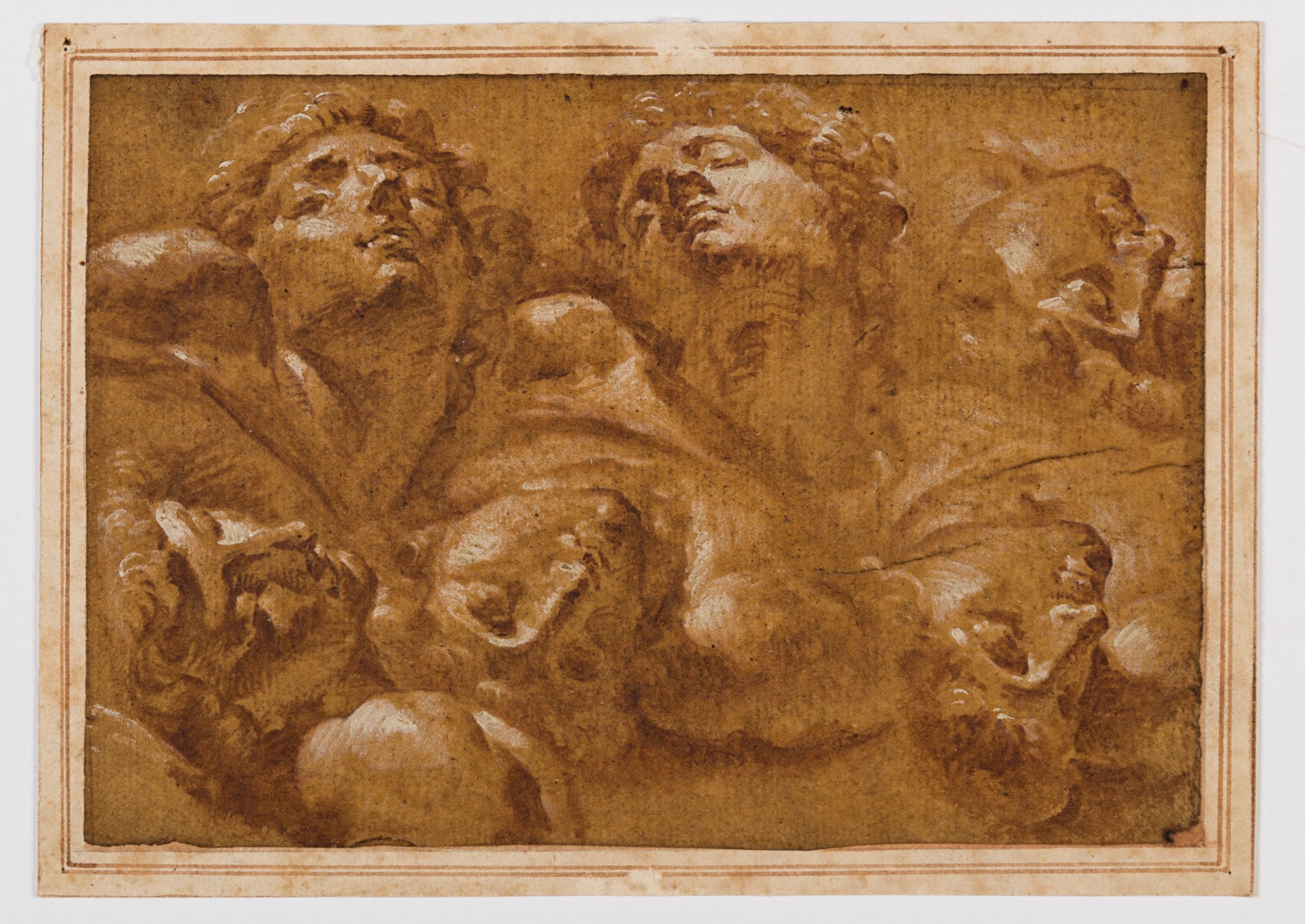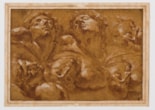Edward DUBOIS
(Antwerp 1619 - London 1697)
Six Studies of the Head of Michelangelo’s Dying Slave
Sold
Brush and brown ink and brown wash, heightened with white, on ochre prepared paper, laid down on an old mount with double framing lines in brown ink.
A small loss at the lower right corner.
Inscribed Ceur foriant qu-(?) on the reverse of the old mount.
110 x 158 mm. (4 3/8 x 6 1/8 in.)
A small loss at the lower right corner.
Inscribed Ceur foriant qu-(?) on the reverse of the old mount.
110 x 158 mm. (4 3/8 x 6 1/8 in.)
The present sheet may be grouped with a handful of drawings, usually on a small scale and executed in brush and wash on prepared paper, which have been generally attributed to the Flemish artist Edward Dubois (or Du Bois) or, occasionally, his younger brother Simon (1632-1708).
While it has sometimes proved difficult to distinguish between the drawings of Edward and Simon Dubois, the present sheet may be more favourably attributed to the elder brother. It is he who seems to have been responsible for a small but distinctive group of drawings on prepared paper which take the form of several studies of a particular motif seen from various angles, to judge from a sheet of studies of various male nudes, inscribed ‘Dubois’, in the Metropolitan Museum of Art in New York, as well as another drawing of nude and draped figures, which is inscribed ‘Du Boise’ and ‘Edward’, at Christ Church in Oxford.
This drawing depicts, from a number of different viewpoints, the head of Michelangelo’s sculpture known as The Dying Slave, carved between 1513 and 1516 and intended for the tomb of Pope Julius II. Measuring well over two metres in height, this famous marble sculpture is today in the Louvre. By the mid-17th century, Michelangelo’s Dying Slave, together with a pendant sculpture known as the Rebellious Slave, had been installed in the Château de Richelieu, between Poitiers and Tours in west-central France. Although Dubois may have spent some time in France, it is unlikely that he would have seen the sculpture itself. Instead, the artist was here probably working from a small bronze cast or terracotta model of the head of the Dying Slave, which he would have allowed him to study and draw it from several angles.
Closely comparable drawings by Edward Dubois include a sheet of studies of the head of an infant, formerly in the collection of Michael Jaffé, sold at auction in 2019, and a drawing of seven studies of the head of a bearded man, which also appeared at auction in 2019.
While it has sometimes proved difficult to distinguish between the drawings of Edward and Simon Dubois, the present sheet may be more favourably attributed to the elder brother. It is he who seems to have been responsible for a small but distinctive group of drawings on prepared paper which take the form of several studies of a particular motif seen from various angles, to judge from a sheet of studies of various male nudes, inscribed ‘Dubois’, in the Metropolitan Museum of Art in New York, as well as another drawing of nude and draped figures, which is inscribed ‘Du Boise’ and ‘Edward’, at Christ Church in Oxford.
This drawing depicts, from a number of different viewpoints, the head of Michelangelo’s sculpture known as The Dying Slave, carved between 1513 and 1516 and intended for the tomb of Pope Julius II. Measuring well over two metres in height, this famous marble sculpture is today in the Louvre. By the mid-17th century, Michelangelo’s Dying Slave, together with a pendant sculpture known as the Rebellious Slave, had been installed in the Château de Richelieu, between Poitiers and Tours in west-central France. Although Dubois may have spent some time in France, it is unlikely that he would have seen the sculpture itself. Instead, the artist was here probably working from a small bronze cast or terracotta model of the head of the Dying Slave, which he would have allowed him to study and draw it from several angles.
Closely comparable drawings by Edward Dubois include a sheet of studies of the head of an infant, formerly in the collection of Michael Jaffé, sold at auction in 2019, and a drawing of seven studies of the head of a bearded man, which also appeared at auction in 2019.
The Flemish artist Edward Dubois (or Du Bois) was the son of the painter Hendrick du Bois. Both Edward and his younger brother Simon Dubois (1632-1708) lived and worked in Holland and Italy, including some time in Venice in 1657, before eventually settling in England around 1680. Little is known of either artist, although Simon was active mainly as a portrait painter and miniaturist, and also seems to have been a gifted copyist of the Old Masters. Edward Dubois was trained in the studio of Philips Wouwerman in Haarlem, and is recorded in 1638 in Rotterdam and again in 1646 in Haarlem, before settling, with his brother, in London in 1680. Edward Dubois is mostly known as a printmaker and publisher, having published prints by Cornelis Visscher after Pieter van Laer, as well as prints after portraits of his parents by Van Dyck.




